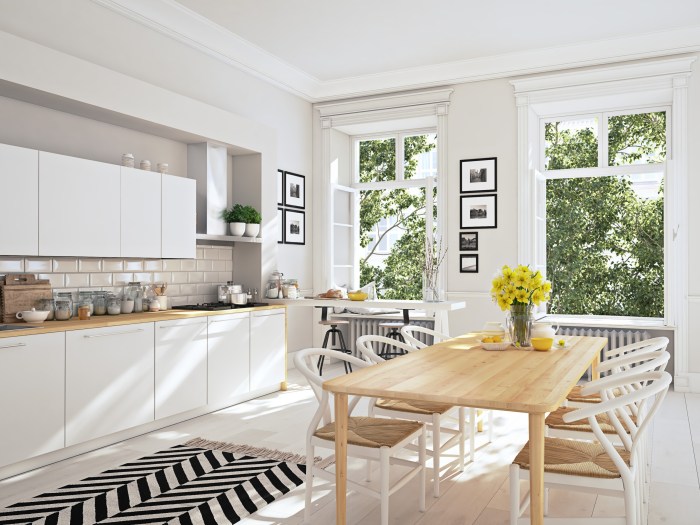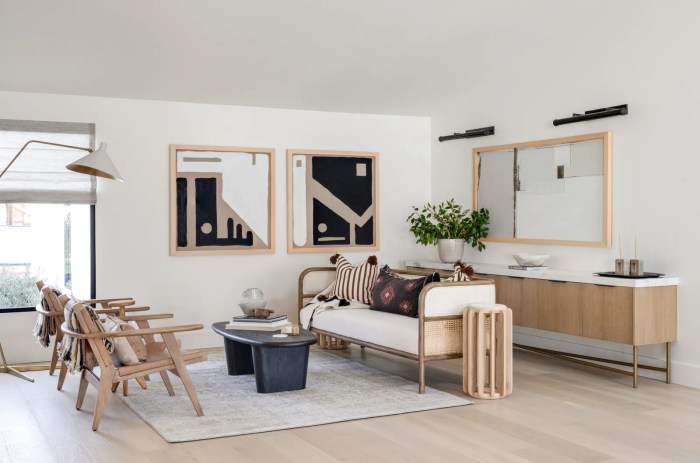Step into the world of Scandinavian interior design where simplicity meets functionality, creating a harmonious balance that is both timeless and inviting. From the use of natural elements to the emphasis on cozy atmospheres, this design style offers a unique blend of comfort and elegance.
Let's delve into the key aspects that define this captivating aesthetic.
Definition of Scandinavian Interior Design
Scandinavian interior design is a minimalist and functional style that originates from the Nordic countries. It focuses on simplicity, clean lines, natural elements, and a sense of light and space.
Core Principles of Scandinavian Interior Design
- Functionality: Furniture and decor should serve a purpose and be practical.
- Simplicity: Minimalist approach with clutter-free spaces.
- Natural Light: Maximizing natural light to create a bright and airy atmosphere.
- Nature-Inspired Elements: Incorporating natural materials like wood, stone, and plants.
Key Elements of Scandinavian Interior Design
- Neutral Color Palette: Whites, grays, and earthy tones are commonly used to create a sense of calm.
- Light Wood: Light-colored woods like pine and birch are prevalent in furniture and flooring.
- Textiles: Cozy textiles such as wool, sheepskin, and linen add warmth and texture to the space.
- Functional Furniture: Pieces that are simple, sleek, and multi-functional are favored in Scandinavian design.
Examples of Color Schemes
Scandinavian design often incorporates a muted color palette to create a serene and harmonious environment. Some common color schemes include:
- White walls with light gray accents
- Soft pastels like pale blue and blush pink
- Earthy tones such as warm browns and soft greens
Characteristics of Scandinavian Interior Design
Scandinavian interior design is known for its unique characteristics that emphasize simplicity, functionality, and a connection to nature. Let's delve into the key features that define this popular design style.
Emphasis on Natural Light
Scandinavian interior design places a significant emphasis on natural light, maximizing the use of large windows and light-colored walls to create bright and airy spaces. The abundant natural light not only enhances the overall aesthetic but also contributes to a sense of well-being and warmth within the home.
Use of Natural Materials
Natural materials such as wood, stone, and leather play a crucial role in Scandinavian interior design. These elements bring a sense of warmth, texture, and authenticity to the space, creating a harmonious connection with the natural world. Whether it's exposed wooden beams, stone accents, or leather upholstery, these materials add depth and character to the design.
Minimalist Furniture and Clean Lines
One of the hallmarks of Scandinavian interior design is its minimalist approach to furniture and decor. Clean lines, simple forms, and uncluttered spaces are key elements that contribute to the sleek and contemporary aesthetic of this style. Functional furniture pieces with a focus on practicality and comfort are favored, creating a sense of tranquility and balance in the home.
Color Palette in Scandinavian Interior Design

In Scandinavian interior design, the color palette is typically characterized by a combination of neutral tones and pops of color. The overall look is known for its light, airy, and minimalist feel, creating a sense of calm and tranquility.
Neutral Tones vs. Pops of Color
Neutral tones such as white, beige, gray, and soft pastels are commonly used as the base colors in Scandinavian interiors. These colors help to create a clean and fresh backdrop that reflects natural light, making the space appear larger and more open.
Pops of color are then added through accessories, artwork, or furniture to provide contrast and visual interest.
- For example, you can incorporate pops of color through throw pillows, rugs, or decorative objects in shades of blue, green, or mustard yellow to add warmth and personality to a neutral space.
- Incorporating natural elements such as wooden furniture or plants can also introduce pops of color in earthy tones like forest green or warm browns.
Furniture and Decor in Scandinavian Interior Design

In Scandinavian interior design, furniture and decor play a crucial role in creating a clean, minimalist, and functional space that exudes warmth and coziness. Let's explore the characteristics of furniture, storage solutions, and decor items commonly found in Scandinavian interiors.
Characteristics of Furniture in Scandinavian Interior Design
Scandinavian furniture is known for its simplicity, clean lines, and functionality. Common materials include light-colored woods like beech, ash, and pine, which help reflect light and create an airy feel in the space. Furniture pieces are often sleek and streamlined, with an emphasis on practicality and comfort.
Functional and Stylish Storage Solutions
In Scandinavian interiors, storage solutions are seamlessly integrated into the design to maintain a clutter-free and organized space. Furniture pieces like storage ottomans, modular shelving units, and built-in cabinets provide both functionality and style. Opt for multifunctional pieces that serve a dual purpose to maximize space efficiently.
Tips for Choosing Decor Items
- Textiles: Incorporate cozy textures like wool throws, sheepskin rugs, and knitted cushions to add warmth and comfort to the space.
- Lighting: Opt for minimalist lighting fixtures like pendant lights, floor lamps, and wall sconces to create a soft and inviting ambiance.
- Artwork: Choose simple and elegant artwork pieces like black and white photographs, abstract prints, or nature-inspired paintings to enhance the aesthetic of the room without overwhelming the design.
Creating a Cozy Atmosphere in Scandinavian Interiors

Creating a warm and inviting atmosphere in Scandinavian interiors is essential to balance the minimalist aesthetic with comfort. By incorporating specific elements and textures, you can achieve a cozy feel without sacrificing the clean and simple design principles.
Importance of Textures
Adding textures like faux fur, knits, and sheepskin can instantly enhance the coziness of a room. These soft and tactile materials provide warmth and comfort, creating a welcoming ambiance. Incorporating these textures through throws, pillows, and rugs can soften the overall look of the space and make it more inviting.
Integrating Elements like Candles and Natural Materials
Candles are a hallmark of Scandinavian design and play a significant role in creating a cozy atmosphere. The soft glow of candles can add warmth and intimacy to a room, especially during the long winter months. Additionally, natural materials like wood, stone, and plants bring a sense of nature indoors, contributing to a tranquil and cozy environment.
By incorporating these elements thoughtfully, you can transform a space into a cozy retreat that still maintains the Scandinavian aesthetic.
Final Thoughts
In conclusion, Scandinavian interior design captures the essence of modern living with its clean lines, minimalist approach, and focus on creating warm, inviting spaces. Embracing natural light, neutral tones, and functional furniture, this style effortlessly combines comfort with sophistication. Whether you're looking to revamp your home or simply draw inspiration, Scandinavian design offers a world of possibilities to explore.
Commonly Asked Questions
What are the core principles of Scandinavian interior design?
Scandinavian interior design focuses on simplicity, functionality, and minimalism, with an emphasis on creating bright, airy spaces.
How can I add coziness to a Scandinavian-inspired room?
You can incorporate textures like faux fur, knits, and sheepskin, along with elements like candles and natural materials, to enhance the cozy atmosphere.
What colors are commonly used in Scandinavian design?
Neutral tones like whites, grays, and beiges are prevalent in Scandinavian interiors, often complemented by pops of muted colors like blues or greens.
What types of furniture are typically found in Scandinavian interiors?
Scandinavian interiors feature minimalist furniture with clean lines, often made of natural materials like wood, leather, and stone.
